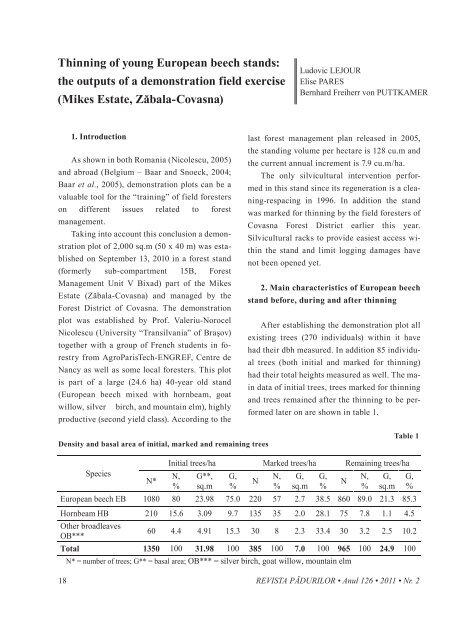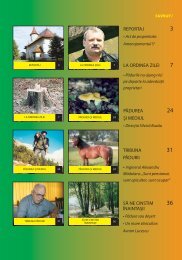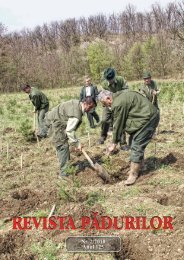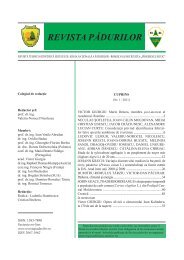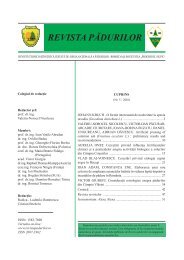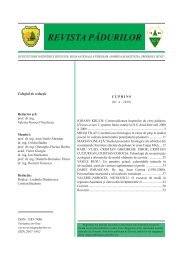şi prof.dr. W. Zwölfer - Revista Pădurilor
şi prof.dr. W. Zwölfer - Revista Pădurilor
şi prof.dr. W. Zwölfer - Revista Pădurilor
Create successful ePaper yourself
Turn your PDF publications into a flip-book with our unique Google optimized e-Paper software.
thinning of young european beech stands:<br />
the outputs of a demonstration field exercise<br />
(Mikes estate, Zăbala-Covasna)<br />
1. Introduction<br />
As shown in both Romania (Nicolescu, 2005)<br />
and abroad (Belgium – Baar and Snoeck, 2004;<br />
Baar et al., 2005), demonstration plots can be a<br />
valuable tool for the “training” of field foresters<br />
on different issues related to forest<br />
management.<br />
Taking into account this conclusion a demonstration<br />
plot of 2,000 sq.m (50 x 40 m) was established<br />
on September 13, 2010 in a forest stand<br />
(formerly sub-compartment 15B, Forest<br />
Management Unit V Bixad) part of the Mikes<br />
Estate (Zăbala-Covasna) and managed by the<br />
Forest District of Covasna. The demonstration<br />
plot was established by Prof. Valeriu-Norocel<br />
Nicolescu (University “Transilvania” of Braşov)<br />
together with a group of French students in forestry<br />
from AgroParisTech-ENGREF, Centre de<br />
Nancy as well as some local foresters. This plot<br />
is part of a large (24.6 ha) 40-year old stand<br />
(European beech mixed with hornbeam, goat<br />
willow, silver birch, and mountain elm), highly<br />
productive (second yield class). According to the<br />
Density and basal area of initial, marked and remaining trees<br />
Species<br />
N*<br />
last forest management plan released in 2005,<br />
the standing volume per hectare is 128 cu.m and<br />
the current annual increment is 7.9 cu.m/ha.<br />
The only silvicultural intervention performed<br />
in this stand since its regeneration is a cleaning-respacing<br />
in 1996. In addition the stand<br />
was marked for thinning by the field foresters of<br />
Covasna Forest District earlier this year.<br />
Silvicultural racks to provide easiest access within<br />
the stand and limit logging damages have<br />
not been opened yet.<br />
2. Main characteristics of european beech<br />
stand before, during and after thinning<br />
After establishing the demonstration plot all<br />
existing trees (270 individuals) within it have<br />
had their dbh measured. In addition 85 individual<br />
trees (both initial and marked for thinning)<br />
had their total heights measured as well. The main<br />
data of initial trees, trees marked for thinning<br />
and trees remained after the thinning to be performed<br />
later on are shown in table 1.<br />
Initial trees/ha Marked trees/ha Remaining trees/ha<br />
N,<br />
%<br />
G**,<br />
sq.m<br />
G,<br />
%<br />
18 REVISTA PĂDURILOR • Anul 126 • 2011 • Nr. 2<br />
N<br />
N,<br />
%<br />
Ludovic LEJOUR<br />
Elise PARES<br />
Bernhard Freiherr von PUTTKAMER<br />
G,<br />
sq.m<br />
G,<br />
%<br />
N<br />
N,<br />
%<br />
G,<br />
sq.m<br />
Table 1<br />
European beech EB 1080 80 23.98 75.0 220 57 2.7 38.5 860 89.0 21.3 85.3<br />
Hornbeam HB 210 15.6 3.09 9.7 135 35 2.0 28.1 75 7.8 1.1 4.5<br />
Other broadleaves<br />
OB***<br />
60 4.4 4.91 15.3 30 8 2.3 33.4 30 3.2 2.5 10.2<br />
Total 1350 100 31.98 100 385 100 7.0 100 965 100 24.9 100<br />
N* = number of trees; G** = basal area; OB*** = silver birch, goat willow, mountain elm<br />
G,<br />
%


